Providing AI models with high-quality data annotation is important for success in the application domains of autonomous vehicles and ADAS. Osiz, being a pioneering AI Development Company, is at the forefront of this innovation with a scalable solution crafted to ensure the medium and long sequences of frames are correctly and quickly annotated, thus forming a core element of the automotive AI models.
Why Data Labelling is Necessary in the Automotive Industry?
Labeling plays a role in the advancement of self-driving vehicles by aiding in the training of algorithms boosting perception and recognition capabilities enhancing decision making ensuring safety and dependability adapting to various environments and facilitating continuous improvement. The absence of data labeling would pose challenges to the advancement and implementation of autonomous driving technologies hindering their capacity to function securely and efficiently on public roadways.
Role of Data Annotation in the Automotive Sector
The most common fundamental roles of data annotation in autonomous vehicles are:
Object Detection: This is the task of detecting the presence of more than one object in an image or video frame and localization of their positions, unlike assigning a single class label to the whole image. It detects the answer to many objects of interest and their positions.
Lane Detection: Annotating lane markings, road boundaries, and curbs will enable an AV to understand the geometry of the road and keep its lane during motion.
Mapping and Localization: Labeling a subset of key features and landmarks from sensor data into detailed maps that would eventually help support accurate localization.
Projection and Planning: These are parts of the AI system that provide an autonomous vehicle with the ability to identify the environment, project what might happen next, and thus make prudent decisions in moving the vehicle around safely and efficiently.
Types of Data Used in the Automotive Industry
Images: Camera images are an integral part of the automotive industry in enhancing vehicle safety and autonomy. Images depict scenes in front of a vehicle, showing pedestrians, traffic signs, and other relevant objects. It is through the analysis of these images that vehicles will be able to interpret their environment and act accordingly; therefore, enabling safe navigation.
Videos: They are streams of images that can be used to extract temporal information, something very critical to advanced vehicle systems. In self-driving cars, video data is used in motion forecasting and behavior analysis to allow the vehicle to understand and predict the movement of objects over time. This feature allows it to navigate through dynamic environments where the estimation of trajectories made by other vehicles, pedestrians, and obstacles is important in ensuring safe driving.
3D LiDAR Data: The LiDAR sensors capture shape and depth data of the environment in a three-dimensional manner. This 3D LiDAR data is very important for mapping surroundings and detecting obstacles in order to enable the autonomous vehicle to move through complex terrains with high-precision navigation. Proper perception of the environment in three dimensions is extremely important for the vehicle's ability to make appropriate navigational decisions under any difficult conditions.
Proprioceptive Sensor Data: This is the internal state and conditions of the vehicle. They include very vital information concerning the vehicle, like the GPS location, steering angle, and speed. This information is very crucial in behavior analysis and self-observation, whereby the vehicle can monitor itself to make any necessary adjustments in real-time. By continuously assessing its internal state, a vehicle will be able to optimize its operation for both efficiency and safety.
Exteroceptive Sensor Data: Distance from the vehicle to surrounding places is measured by exteroceptive sensor data, using sensors such as radar and ultrasonic detectors. This is crucial data in object detection along the route the vehicle is taking to avoid collision. Distance toward surrounding objects may be continuously measured by the vehicle to proactively adjust and assure safe operation under a variety of driving conditions.
Conclusion
Excellence, innovation, and responsible Data annotation service provider is the motto of Osiz that indeed has shot us to great success in the field of automobiles. Our solutions aid not only in enhancing the performance of AI models but also work towards building a safer and responsible AI ecosystem for everyone alive.
Listen To The Article
Recent Blogs

X-Mas 30%
Offer











